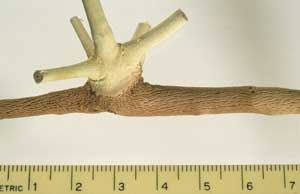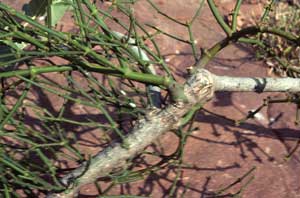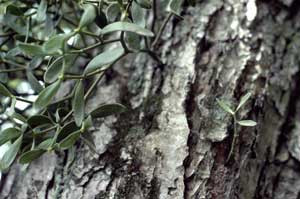What is a mistletoe ?
Haustorial structure
|
Some mistletoes (including most Australian species) produce only a single (primary) haustorium, which actually develops from the root zone of the embryo (see Dispersal and Germination). This primary haustorium can become large and complex, often forming a bulbous union with the host (right). Other mistletoes produce epicortical runners ![]() , roots which grow in vine-like fashion along the outside of the host branch, sending down relatively simple secondary haustoria at regular intervals (below). Epicortical runners are more common in mistletoes of humid forests. They may be a less specialized state (see Origin of the Mistletoe Habit), and the direction of evolution may have been towards a more efficient primary haustorium, and consequent reduction and loss of the epicortical runners.
, roots which grow in vine-like fashion along the outside of the host branch, sending down relatively simple secondary haustoria at regular intervals (below). Epicortical runners are more common in mistletoes of humid forests. They may be a less specialized state (see Origin of the Mistletoe Habit), and the direction of evolution may have been towards a more efficient primary haustorium, and consequent reduction and loss of the epicortical runners.
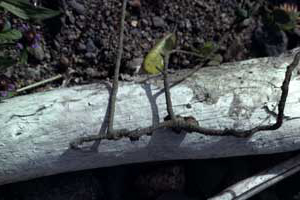 |
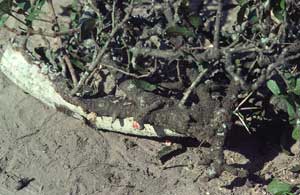 |
There is considerable diversity in the complexity of the primary haustorium in those species which lack epicortical runners. In particular, there are many species in which haustorial strands grow internally within the host, spreading from the initial point of attachment. They grow in the cambial zone of the host, mostly downwards, towards the source of water and mineral nutrients. In some species these cortical strands produce secondary shoots which erupt through the bark, producing stems, leaves and flowers much like root suckers in terrestrial shrubs (right). In Diplatia grandibractea of inland Australia these strands can reach 5 m in length, and produce many secondary shoots over a wide area. Thus even though a mistletoe may appear to have only a single primary haustorium, there may be a network of absorbing strands spreading within the host. Occasionally, as these strands become woody, they may break through the host’s bark (left below), and although they may then resemble epicortical runners, they are quite different, and represent a much higher level of specialization.
![An Australian Government Initiative [logo]](/images/austgovt_brown_90px.gif)


